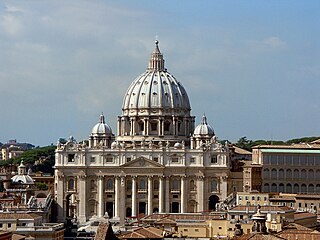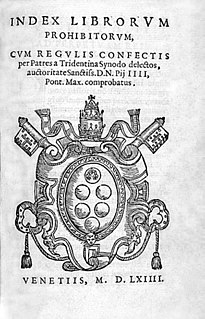
The Second Ecumenical Council of the Vatican, commonly known as the Second Vatican Council, or Vatican II, was the 21st ecumenical council of the Roman Catholic Church. The council met in St. Peter's Basilica in Rome for four periods, each lasting between 8 and 12 weeks, in the autumn of each of the four years 1962 to 1965. Preparation for the council took three years, from the summer of 1959 to the autumn of 1962. The council was opened on 11 October 1962 by John XXIII, and was closed on 8 December 1965 by Paul VI.

The Index Librorum Prohibitorum was a list of publications deemed heretical or contrary to morality by the Sacred Congregation of the Index, and Catholics were forbidden to read them.

In the Catholic Church, the Congregation for the Causes of Saints is the congregation of the Roman Curia that oversees the complex process that leads to the canonization of saints, passing through the steps of a declaration of "heroic virtues" and beatification. After preparing a case, including the approval of miracles, the case is presented to the pope, who decides whether or not to proceed with beatification or canonization. This is one of nine Vatican Curial congregations.

A papal conclave is a gathering of the College of Cardinals convened to elect a bishop of Rome, also known as the pope. Catholics consider the pope to be the apostolic successor of Saint Peter and the earthly head of the Catholic Church.

The Congregation for the Clergy is the congregation of the Roman Curia responsible for overseeing matters regarding priests and deacons not belonging to religious orders. The Congregation for the Clergy handles requests for dispensation from active priestly ministry, as well as the legislation governing presbyteral councils and other organisations of priests around the world. The Congregation does not deal with clerical sexual abuse cases, as those are handled exclusively by the Congregation for the Doctrine of the Faith.
Quattuor abhinc annos is the incipit of a letter that the Congregation for Divine Worship and the Discipline of the Sacraments sent on 3 October 1984 to presidents of episcopal conferences concerning celebration of Mass in the Tridentine form.

The Congregation for Catholic Education is the pontifical congregation of the Roman Curia responsible for: (1) universities, faculties, institutes and higher schools of study, either ecclesial or non-ecclesiastical dependent on ecclesial persons; and (2) schools and educational institutes depending on ecclesiastical authorities.
In the Roman Curia, a congregation is a type of department of the Curia. They are second-highest-ranking departments, ranking below the two Secretariats, and above the pontifical councils, pontifical commissions, tribunals and offices.
Jus exclusivae was the right claimed by several Catholic monarchs of Europe to veto a candidate for the papacy. Although never formally recognized by the Catholic Church, the French monarch, the Spanish monarch, and the Holy Roman Emperor claimed this right at various times, making known to a papal conclave, through a crown-cardinal, that the monarch deemed a particular candidate for the papacy objectionable.
The Sacred Congregation of Rites was a congregation of the Roman Curia, erected on 22 January 1588 by Pope Sixtus V by Immensa Aeterni Dei and its functions reassigned by Pope Paul VI on 8 May 1969.
Ecclesiastical letters are publications or announcements of the organs of Roman Catholic ecclesiastical authority, e.g. the synods, but more particularly of pope and bishops, addressed to the faithful in the form of letters.
Aloisio Gardellini was an Italian editor and compiler of religious documents.
Dei patris immensa was a letter written by Pope Innocent IV to the Mongols. It was written on March 5, 1245, was an exposition of the Christian faith, and urged Mongols to accept baptism. It was intended to be carried by the Franciscan friar and papal envoy Laurentius of Portugal. However, nothing more is known about Laurentius' embassy, and it is possible that he never actually left.

The history of the Roman Curia, the administrative apparatus responsible for managing the affairs of the Holy See and the Catholic Church, can be traced to the 11th century when informal methods of administration began to take on a more organized structure and eventual a bureaucratic form. The Curia has undergone a series of renewals and reforms, including a major overhaul following the loss of the Papal States, which fundamentally altered the range and nature of the Curia's responsibilities, removing many of an entirely secular nature.

Santa Maria Odigitria, sometimes Santa Maria dei Siciliani, is a Roman Catholic church in Rome, located at civico 82 on via del Tritone in the Colonna district.
Vultum Dei quaerere is an apostolic constitution issued by Pope Francis on 22 July 2016, regarding women's contemplative life.
The Sacred Congregation of the Consulta or Sacra Consulta was a dicastery of the Roman Curia. It was set up as a 'special commission' by pope Paul IV in 1559 and officialised on 22 January 1588 by Pope Sixtus V in the papal bull Immensa Aeterni Dei. Sixtus named it the 'Congregation over the consultations of the ecclesiastical state' and established its composition of four cardinals, the Secretary of State as prefect and a suitable number of prelates, one of whom would act as secretary.
The Holy Congregation of the Vatican Press was an organ of the Roman Curia.
Liturgical use of Latin is the practice of performing Christian liturgy in the language of Ecclesiastical Latin, typically in the context of liturgical rites of the Latin Church.






